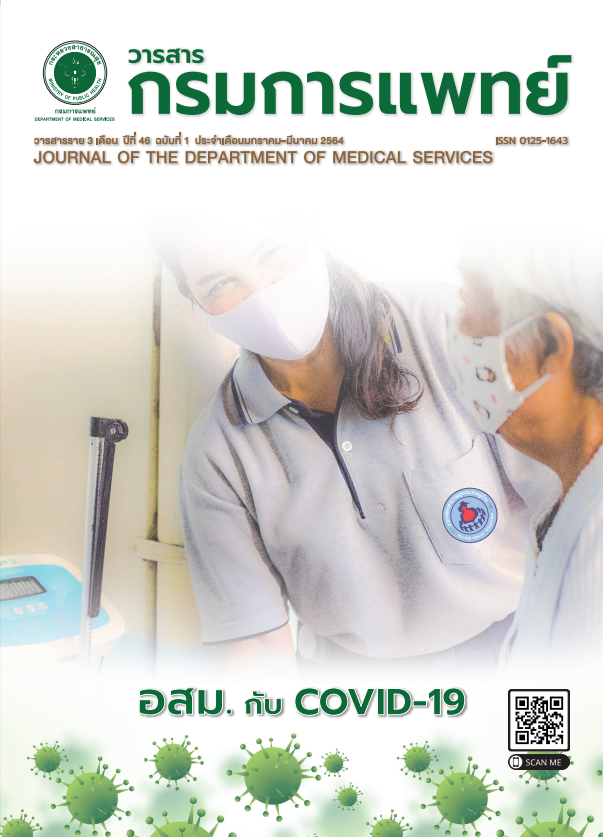การพัฒนารูปแบบการพยาบาลต่อเนื่องในผู้ป่วยโรคตุ่มน้ำพองใส สถาบันโรคผิวหนัง
คำสำคัญ:
การดูแลต่อเนื่อง, การพยาบาล, ผู้ป่วยโรคตุ่มน้ำพองใส, การพัฒนารูปแบบบทคัดย่อ
ภูมิหลัง : โรคตุ่มน้ำพองใสเป็นโรคผิวหนังเรื้อรังที่มีความ ผิดปกติของภูมิคุ้มกันตนเอง มีความรุนแรงของโรคหลายระดับ ส่งผลต่อคุณภาพชีวิตและมีโอกาสเสียชีวิตได้จากความรุนแรงของ โรคหรือภาวะแทรกซ้อนจากการติดเชื้อและการใช้ยากดภูมิคุ้มกัน เพื่อลดภาวะแทรกซ้อนของโรคผู้ป่วยจำเป็นต้องได้รับการดูแลต่อ เนื่องจากโรงพยาบาลถึงบ้าน
วัตถุประสงค์ : เพื่อพัฒนาและศึกษา ผลการใช้รูปแบบการพยาบาลต่อเนื่องในผู้ป่วยโรคตุ่มน้ำพองใส
วิธีการ : การศึกษาครั้งนี้เป็นการวิจัยและพัฒนา (research and development) กลุ่มตัวอย่างเป็นพยาบาลวิชาชีพ จำนวน 17 คน และผู้ป่วยจำนวน 68 ราย แบ่งเป็นผู้ป่วยความรุนแรงระดับปาน กลางขึ้นไป จำนวน 8 รายและผู้ป่วยความรุนแรงระดับน้อย จำนวน 60 ราย ที่มารักษาสถาบันโรคผิวหนัง วิเคราะห์ข้อมูลรูปแบบการ พยาบาลต่อเนื่องในผู้ป่วยโรคตุ่มน้ำพองใสด้วยการวิเคราะห์เนื้อหา และสถิติเปรียบเทียบก่อนหลังการพัฒนารูปแบบฯ ด้วย Wilcoxon signed-rank test และ Paired t-test
ผล : พบว่า รูปแบบการ พยาบาลต่อเนื่องในผู้ป่วยโรคตุ่มน้ำพองใส ประกอบด้วย 1) แนวทาง ปฏิบัติการพยาบาลผู้ป่วยโรคตุ่มน้ำพองใส 2) โปรแกรมวางแผน จำหน่าย 3) แผนการสอนสุขศึกษาผู้ป่วย 4) สมุดประจำตัวผู้ป่วย โรคตุ่มน้ำพองใส 5) การมอบหมายพยาบาลติดตามอาการผู้ป่วย ที่บ้านทางโทรศัพท์ 6) การส่งต่อข้อมูลปัญหาผู้ป่วยระหว่างหอ ผู้ป่วยกับคลินิกเฉพาะโรคตุ่มน้ำพองใส หลังจากการใช้รูปแบบฯ พบว่า พยาบาลวิชาชีพมีความรู้สูงขึ้นกว่าก่อนการพัฒนารูปแบบฯ อย่างมีนัยสำคัญทางสถิติ (p<0.05) สามารถปฏิบัติได้ตามรูปแบบ การพยาบาลโดยมีค่าเฉลี่ย 86.42% และมีความพึงพอใจต่อการใช้ รูปแบบในระดับมากที่สุด ในผู้ป่วยที่มีความรุนแรงทุกระดับ พบว่า มีความรู้สูงขึ้นอย่างมีนัยสำคัญทางสถิติ (p<0.05) ผู้ป่วยที่มีความ รุนแรงของโรคระดับน้อย มีคะแนนเฉลี่ยพฤติกรรมการดูแลตนเอง สูงขึ้นอย่างมีนัยสำคัญทางสถิติ (p<0.05) แม้ว่าผู้ป่วยที่มีความรุนแรง ของโรคระดับปานกลางขึ้นไป มีคะแนนเฉลี่ยพฤติกรรมการดูแล ตนเองก่อนและหลังการพัฒนารูปแบบฯไม่แตกต่างกัน (p>0.05) ผู้ป่วยความรุนแรงทุกระดับมีความพึงพอใจหลังพัฒนารูปแบบใน ระดับมากที่สุด ผลลัพธ์ทางคลินิก พบว่า ผู้ป่วยที่มีความรุนแรงของ โรคระดับน้อยมีอัตรา re-visit ลดลงจากค่าเฉลี่ยร้อยละ 5.96 เป็น ร้อยละ 1.67 ส่วนผู้ป่วยที่มีความรุนแรงของโรคระดับปานกลางขึ้น ไป มีอัตรา re-admit ลดลงจากค่าเฉลี่ยร้อยละ 4.33 เป็นร้อยละ 0
สรุป : รูปแบบการพยาบาลต่อเนื่องในผู้ป่วยโรคตุ่มน้ำพองใสที่ได้ รับการพัฒนาขึ้นช่วยสนับสนุนการปฏิบัติการของพยาบาลวิชาชีพ ในการดูแลต่อเนื่องส่งผลให้ผู้ป่วยมีความรู้สามารถดูแลตนเองได้ ลดภาวะแทรกซ้อนลดการ re-visit และ re-admit ได้อย่างชัดเจน
เอกสารอ้างอิง
Payne AS, Stanley JR, Pemphigus. In: Goldsmith LA, Katz SI,Gilchrest BA, Paller AS, Leffell DJ, Wolff K, editors.Fitzpatrick’s dermatology in general medicine. 8th ed. New York: McGraw-hill Medical; 2012.
Sanjir Grover. Scoring system in pemphigus. Indian J Dermatol2011; 56: 145-9.
Phisarnbutr P. Vesiculobullous Disease. In: Kunlavanich P,Phisarnbutr P, editors Dermatology 2010.1st ed.Bangkok: Holistic Publishing Company Limited; 2548.
Sung JY, Roh MR, Kim Sc. Quality of life assessment in Korean patients with pemphigus. Ann Dermatol 2015;27:492-8.
Krain RL, Kushner CJ, Tarazi M, Gaffney RG, Yeguez AC, Zamalin DE, et al. Assessing the correlation between disease severity indices and quality of life measurement tools in pemphigus.Front Immunol2019; 10:2571.
Medical records and statistics, Institute of dermatology Patient Statistics Summary 2016-2018.
Quality Development Division Institute of dermatology Quality Indicators 2016-2018.
Department of Financial and accounting Institute of Dermatology Pemphigus Patients Cost 2015-2016.
Kullavanijaya P, National Dermatology Committee of Thailand,March 26, 2018; Queen sirikit national institute of child health.Bangkok Thailand; 2019.
Tresukosol P, Indicator of institute of dermatology. Supervision of department of medical services, Queen sirikit national institute of child health. Bangkok Thailand; September 3; 2019.
Nasongkhla P, Kwangsukstid O. A Comparition of prednisolone plus oral azathioprine or oral cyclophosphamide versus prednisolone for the treatment of mild pemphigus. Thai J Dermatal2011; 4: 273-83.
Piamphongsant T. Treatment of pemphigus with corticosteroids and cyclophosphamide. J Dermatol1979 ;6:359-63.
Haggerty JL, Roberqe D, Freeman GK, Beaulieu C, Breton M.Validation of a generic measure of continuity of care: when patients encounter several clinicians. Ann Fam Med 2012; 10:443–51.
Teeranut A. Sangsom D. Metakarnjanasak N. Rouysungnon W.Development of a holistic continuing care model for elderly with chronic illnesses: a case study in a tertiary care hospital.Journal of nurses’ Association of Thailand North-eastern Division 2009; 27: 65-77.
Nillake K, Chantra R. The Effects of Discharge program for Burn Patients on Self-care ability and Quality of life in Surgical 4 Department Suratthani Hospital. Medica Journal 2019; 33:143-56.
Thongchai C. Clinical Practice Guidelines Development. The Thai Journal of Nursing Council 2005; 20: 63-74.
Souza-Junior VD, Mendes IA, Mazzo A, Godoy S. Application of telenursing in nursing practice: an integrative literature review.Appl Nurs Res2016;29:254-60.
Kawaguchi T, Azuma M, Ohta K. Development of a telenursing system for patients with chronic conditions. J Telemed Telecare 2004;10:239-44.
Ratintorn A. Continuity of care: the core of quality improvement in midwifery practice. 1st ed. Bangkok:Wattanaprinting; 2016.
Sakcharoen P. Adult learning theory and Self-directed learning concept: process for promoting lifelong learning. Journal of the Royal Thai Army Nurses 2015; 16: 8-13.
Arpaichiraratana C, Attharos T. Effect of small group discussion on critical thinking, self-directed learning,satisfaction on the learning of nursing students of The Thai Red Cross College of Nursing. Thai Red Cross Nursing Journal 2012 ; 5 : 21-31.
Sikkabandit S. Education Technology. 11th ed. Bangkok : King Mongkut’s Institute of Technology North Bangkok Printing Press; 2528.
ดาวน์โหลด
เผยแพร่แล้ว
รูปแบบการอ้างอิง
ฉบับ
ประเภทบทความ
สัญญาอนุญาต

อนุญาตภายใต้เงื่อนไข Creative Commons Attribution-NonCommercial-NoDerivatives 4.0 International License.
บทความที่ได้รับการตีพิมพ์เป็นลิขสิทธิ์ของกรมการแพทย์ กระทรวงสาธารณสุข
ข้อความและข้อคิดเห็นต่างๆ เป็นของผู้เขียนบทความ ไม่ใช่ความเห็นของกองบรรณาธิการหรือของวารสารกรมการแพทย์



